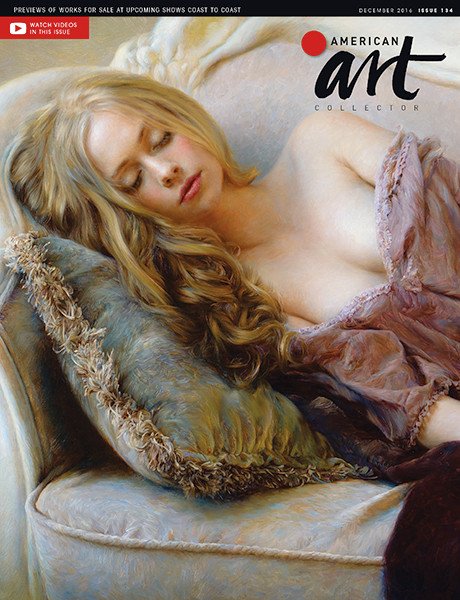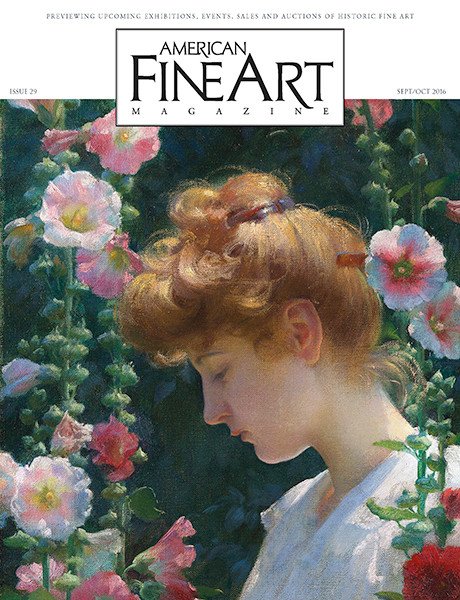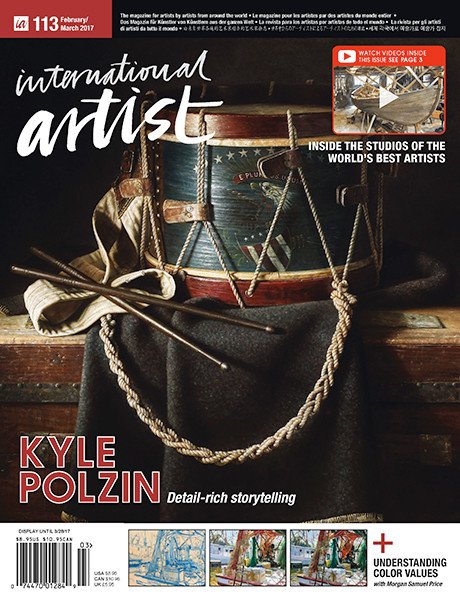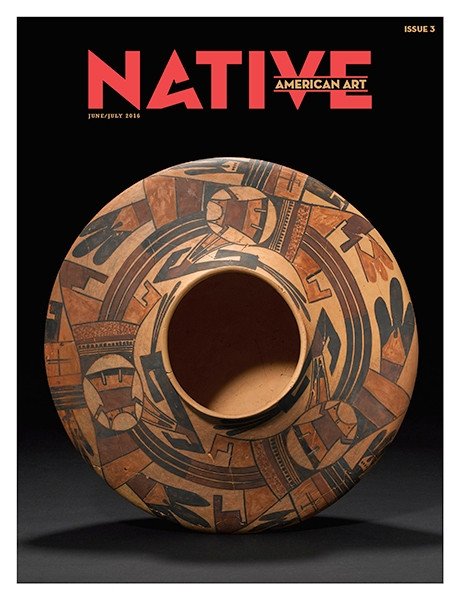An ice storm blasted through New England in 1921. So devastating was the storm that the local newspaper described it “as if a giant striding over the town had swung a scythe.” The storm (or maybe just the newspaper article) must have made an impact, because in 1923, after being commissioned by the 1910 class of Westtown School, N.C. Wyeth painted The Giant, showing a huge hundreds-foot-tall titan-like figure, club on his shoulder, walking through the ocean off the coast, his body hazy amid the clouds. On the beach are a group of children who stand in quiet astonishment at the sight in front of them.

Dennis Ziemienski, Anvil Top, oil on canvas, 36 x 72 in.
I think about Dennis Ziemienski when I see this painting, not because Ziemienski and Wyeth were both illustrators who turned to fine art, or because they both have similarly bright and exciting palettes, or because both are masters of composition and design—although all of those are true. I think of Ziemienski because the children at the bottom of the Wyeth piece seem frozen in awe at the giant world in front of them. You can’t see their faces, but you can imagine the wonder that lights up their eyes. This is Ziemienski, still beaming up at the grand sights above him.
Dennis Ziemienski, Truck Stop, oil on canvas, 24 x 48 in.
A small child looking up into the large world is essentially how Ziemienski started interacting with his own artistic curiosity. When he was young, he would visit his Polish grandmother in San Francisco. After the sun went down, the lights from Fillmore Street flashed into the rooms. One of the lights was from the sign at Roy Barni’s Huddle, a bar owned by NFL defensive back Roy Barni. The sign featured a kicker in three neon-lit scenes animated into a football punt. The next morning, the youngster launched an inquiry of the now-unlit sign: “My young mind couldn’t imagine what was happening. But then when I went to investigate, I realized it was just glass tubing,” Ziemienski says in his new The Art of Dennis Ziemienski. “I was instantly interested in what was happening with this strange and wonderful technology.”

Dennis Ziemienski, Candy Apple Town & Country, oil on canvas, 24 x 48 in.
What happens next is the early and middle portions of Ziemienski’s life and career: raised in the Bay Area, he enters (and wins) early art contests, fosters an appreciation for Spanish California and its 21 missions, starts college in Northern California, joins the U.S. Navy Submarine Reserve, gets his degree from the California College of Arts and Crafts, joins the National Society of Illustrators and then moves to New York to be an illustrator. At one point in the 1980s, he returns to California, and then within another decade or so, amid the collapse of the illustration market, he turns to fine art. Not long after, he finds himself in Northern California craning his neck upward again, admiring those neon signs. Decades after Roy Barni and they were still mystifying sights. Neon became an important fascination for him, as would other bits of retro Americana, including the kitschy roadside attractions and motor lodges alongside the highway and interstate system; the large novelty restaurants in the shapes of oranges, sombreros, donuts and grand pianos; and the monumental landscapes of the West. It’s here, amid these giants, where Ziemienski would make his home within the art world.

Dennis Ziemienski, Alta California Ranchero, oil on canvas, 72 x 48 in.
The painter is the subject of a suite of events, openings and releases beginning December 6 at Medicine Man Gallery in Tucson, Arizona. First and foremost, there is a major show, Dennis Ziemienski: 50-Year Retrospective, at the gallery; an exhibition, Dixon/Ziemienski: The Illustrators, around the corner at the recently opened Maynard Dixon and Native American Art Museum; and also a book release for The Art of Dennis Ziemienski. (Full disclosure, I wrote all the chapter essays for the book.)
“When [Medicine Man Gallery owner] Mark Sublette asked me to do a major retrospective, I have to admit that my first thought was, ‘So this is it, huh?’ I was honored and thrilled, but I had to wonder if that was the end. I talked to Billy Schenck, who told me he’s had like seven retrospectives, so it cooled me off a bit, which is good because I’m not ready for this to end,” Ziemienski says. “With that shock behind me, I had to really think about my career and what I could unearth for a show. I went through the studio and the attic and I found some really great material.”

Dennis Ziemienski, Fine Cars, oil on canvas, 36 x 48 in.
The artist says there will be close to 60 works in the gallery show, including new works that will be for sale, as well as many older pieces that call back to earlier in his career. The work includes his paintings of roadside attractions, landscapes, Western scenes, his famous diving girls (many of them modeled after his daughter) and those iconic neon signs that so enthralled him as a youngster in San Francisco. One of the themes of the show that visitors might pick up on is the breadth of Ziemienski’s work. He wasn’t purely a cowboy and cattle painter. His definition of the West is broader and encompasses more land and more cultures. California, for instance, plays a large role in his work, not just because he lives in Northern California, but also because he views it as a piece of the American West. “A lot of people feel like the phrase ‘Way Out West’ maybe shouldn’t go that far west. But that is the West,” he says. “It’s entertainment, motels, refreshment stands and all these other great subjects. The West isn’t just cowboys. It’s so much more.”
For Sublette, Medicine Man Gallery’s owner, Ziemienski has been a steady force, a consistent professional and a creative painter. His first encounter with the artist was in 2004, when Ziemienski brought some work to the gallery. “My gaze immediately fixated on a large canvas filled with a horizontal line of horses against a stark desert landscape… [Maynard] Dixon, I thought. He has it but different; it’s a unique interpretation,” Sublette writes in the book’s foreword. “Here was an artist of immense talent, not well known in the Western fine art world, whose body of work was unceremoniously propped up against an unlit gallery wall. It was a thrilling moment to behold.

Maynard Dixon (1875-1946), Thru the beautiful Borderland via Southern Pacific Lines, gouache, 8¾ x 37 in.
I could see our future together, one of a long career honed through discipline and raw talent, awaiting discovery, an exhilarating feeling still palpable today. I was beaming as I moved between canvases, methodically soaking in brushstrokes, composition, color and a variety of subject matter…Dennis was excited and, seeing my unbridled interest, simply asked, ‘Do you see any paintings you would like to handle?’ My reply was direct and heartfelt. ‘All of them—they are great.’ I sold every one of those first paintings in short order, and our storyline began. It has lasted more than 20 years and includes a dozen one- and two-man shows. One of the benefits of representing an artist for two decades is that often, a strong friendship develops, and ours is both heartfelt and meaningful.”

Dennis Ziemienski, Shallow Creek Crossing, oil on canvas, 36 x 48 in.
The exhibition Dixon/Ziemienski: The Illustrators will examine Ziemienski’s role as an illustrator and compare it to the work of Maynard Dixon, whose long association with Sunset Magazine and other publications is still celebrated today. In addition to the events on December 6, there will also be a presentation by Ziemienski on December 5 at Medicine Man Gallery.

Dennis Ziemienski with his new book, The Art of Dennis Ziemienski.
Ziemienski adds that in the build-up to the retrospective, he discovered a huge treasure of slides and other photographic material. After some tinkering with several low-fi digital scanners, the artist has found a way to digitize the images, which will certainly end up in future projects. “I’m compelled to paint anything and everything,” he says. “I never want to stop.” The painter, still in awe of the giants striding across the horizon, can’t take his eyes off his subjects. —
Dennis Ziemienski: 50 Year Retrospective
December 6, 2024-January 5, 2025
Mark Sublette Medicine Man Gallery
6872 E. Sunrise Drive, Suite 130, Tucson, AZ 85750
(520) 722-7798, www.medicinemangallery.com
Dixon/Ziemienski: The Illustrators
December 6, 2024-January 10, 2025
Maynard Dixon and Native American Art Museum
6866 E. Sunrise Drive, Suite 150, Tucson, AZ 85750
(520) 722-7798, www.maynarddixonmuseum.org
Powered by Froala Editor







































